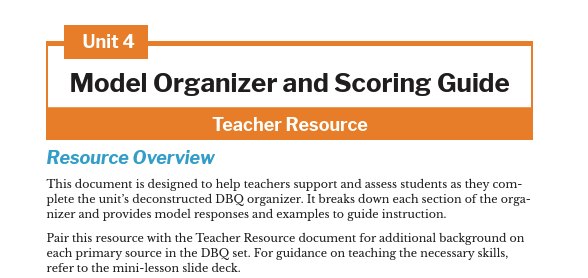Unit 4: Civic and Constitutional Life Model Organizer and Scoring Guide Teacher Resource

Resource Overview
This document is designed to help teachers support and assess students as they complete the unit’s deconstructed DBQ organizer. It breaks down each section of the organizer and provides model responses and examples to guide instruction.
Pair this resource with the Teacher Resource document for additional background on each primary source in the DBQ set. For guidance on teaching the necessary skills, refer to the mini-lesson slide deck.
| Groups: Answers will vary. A sample answer is provided.
Example: Group 1: Principles of the Constitution
Group 2: Effective Citizenship
|
| Question: How can understanding the principles of the Constitution help citizens participate effectively in a democratic society? |
| Thesis: Answers will vary. Sample responses are provided.
Examples:
|
“VIEW”ing the Documents: Answers will vary. Sample responses are provided.
Document A: Excerpt from the Preamble of the U.S. Constitution (1787)
Document B: Excerpt from the First Amendment (1787)
Document C: Excerpt from the Tenth Amendment (1787)
Document D: Excerpt from Federalist #51, James Madison (1788)
Document E: Miranda v. Arizona (1966)
Document F: Engel v. Vitale (1962)
|
Scoring Guides
1-point Rubric
| Evidence of Proficiency | Suggestions for Improvement | |
| Claim
Clearly and directly answers the question with a strong, defensible claim. |
||
| Line of Reasoning
Provides a clear, logical structure that outlines key points. |
||
| Document Analysis
Clearly identifies the author, purpose, historical context, and audience for at least three documents. Provides insightful analysis of the document’s significance. |
||
| VIEW Sentences
VIEW sentences are accurate, well-written, and concise. They effectively explain the document’s significance with strong historical reasoning. |
||
| Document Grouping
Groups documents in a thoughtful and effective way that strengthens the argument. |
||
| Use of Evidence
Effectively integrates relevant evidence from documents to support the claim. |
||
| Clarity & Organization
Thesis is clearly written, well-organized, and easy to understand. |
||
| Mechanics & Grammar
Free of errors in grammar, spelling, and punctuation. |
Scoring Matrix
Total Score: ____ / 32
Comments: